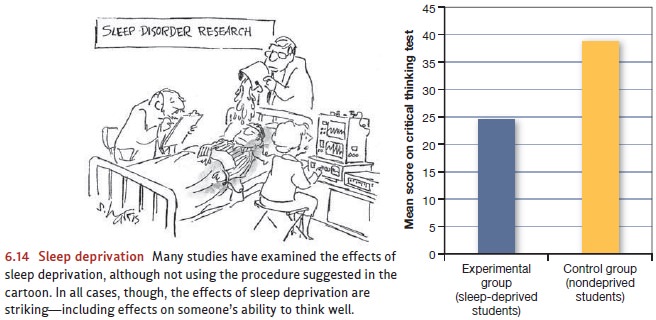Chapter: Psychology: Consciousness
Consciousness: The Need For Sleep
THE NEED FOR SLEEP
Why does sleep have such a
complex architecture, with different stages and different types of activity?
What functions do these individual stages serve? Surprisingly, the answers are
still unknown.
It is clear that sleep does have
some function: If people are deprived of sleep, their alertness decreases, they
complain of feeling poorly, their mood suffers, and they do less well on mental
and physical tasks (Figure 6.14). They express a desire to get to bed as soon
as they can; and when they do get to bed, they rapidly fall asleep (e.g.,
Dinges, Rogers, & Baynard, 2005).

What’s more, people do not just
need sleep; they need adequate amounts of both slow-wave and REM sleep. If, for
example, people are selectively awakened throughout the night during stages 3
and 4, they spend more time the next night in these sleep stages (Bonnet, 2005;
Webb, 1972). Likewise, if they’re awakened during REM periods throughout the
night, they’ll try to make up the lost REM sleep on subsequent nights and spend
more and more of the night in REM sleep as the number of days of REM
deprivation increases. This pattern of REM
rebound is also visible in people who have recently stopped taking
medications that selectively suppress REM sleep—medications that include some
commonly prescribed sleeping pills. When people stop taking these pills, they
may sleep less overall (because they’re no longer being tugged toward sleep by
the pills); but when they do sleep, they’re likely to spend an increased number
of minutes in REM.
Studies also suggest that sleep deprivation—or even just REM sleep deprivation— leads to a compromised immune system, leaving the organism susceptible to bacterial invasion and therefore more vulnerable to a range of illnesses (Everson & Toth, 2000). Indeed, just several nights of partial sleep deprivation can decrease the body’s immune response by half (Spiegel, Sheridan, & Van Cauter, 2002). Sleeplessness also creates other health risks; for example, it’s strongly associated with automobile and workplace accidents (e.g., Walsh, Dement, & Dinges, 2005). Fortunately, though, sleeplessness is easily treated—by letting the person get back to bed! Indeed, even when a person has trouble falling or staying asleep, the problem is easily treatable. Many cases of insomnia respond readily to simple sleep regimens: making the bedroom quiet and dark; keeping bedtimes and waking times constant; refraining from stimulants like caffeine and nicotine after the evening meal; using the bed only for sleep, and getting out of bed if sleep does not come within 15–20 minutes.
How much sleep do we need? The
answer varies from person to person, and it cer-tainly varies with age (Figure
6.15; Iglowstein, Jenni, Molinari, & Largo, 2003; Roffwarg, Muzio, &
Dement, 1966). Infants take brief naps throughout the day; they average about
16 hours of sleep each day and spend half of that time in REM sleep. As
children age, they need appreciably less sleep and spend less time in REM
periods and more time in slow-wave sleep, which is apparently important for
growth and develop-ment. Adolescents average 8 hours per night, 2 of which are
REM sleep. Senior citizens average 6 hours per night, of which only 1 hour is
spent in REM. Some sleep researchers, however, believe that 6 hours is not
enough; they suggest that this amount of sleep—in seniors or anyone—represents
undiagnosed yet treatable insomnia (Dement & Vaughan, 1999).

Let’s emphasize, though, that
these numbers are just averages; some people sleep more and a few sleep much
less. People’s sleep patterns also differ in another way, because people vary
markedly in the timing of their peak alertness during the day. Some people
truly seem to be “morning people”; others are “night people” (Duffy, Rimmer,
& Czeisler, 2001; May & Hasher, 1998). The so-called early birds differ
from the night crew in several ways. The two groups are—as common sense
suggests—distinct in when, during each day, they’re most alert and when they’re
most careful in their judg-ment and reasoning (Bodenhausen, 1990). The groups
also differ in how their body temperature, blood pressure, and digestive rhythm
fluctuate across a 24-hour period.
Why do people differ in these ways? Part of the reason is biological; this is evident in the fact that the various changes associated with puberty seem to produce a shift in daily rhythms. This is why adolescents usually develop a preference for later bedtimes and later rising times—a preference that lasts into early adulthood (Carskadon, Acebo, & Jenni, 2004; also C. Schmidt, Collette, Leclercq, Sterpenich, Vandewalle et al., 2009). Environmental factors also play a role; these factors include the number of hours of daylight a person is exposed to as well as cultural factors such as the prescribed timing of various meals.
Related Topics